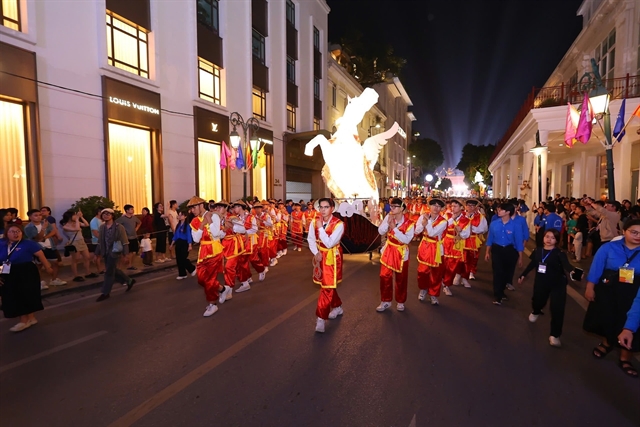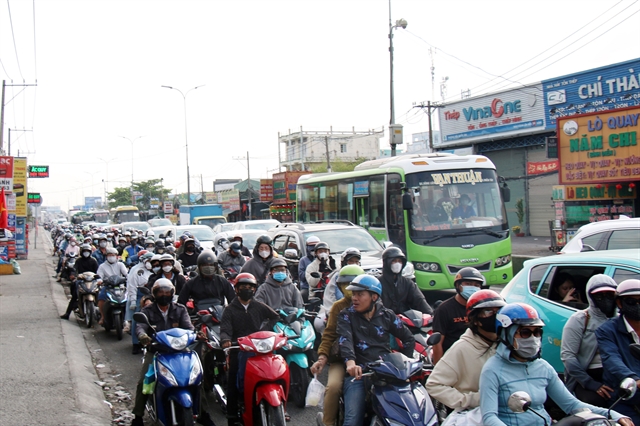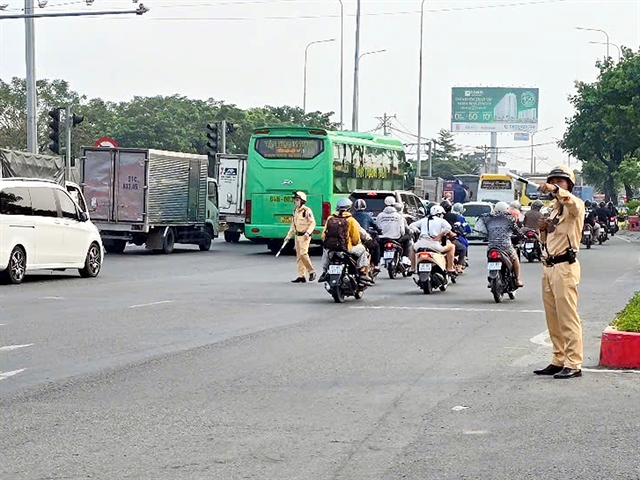 Life & Style
Life & Style


|
| SAFETY LANE: The crowded National Highway 1 intersection Nguyễn Hữu Trí - Hoàng Đạo Thúy in Bình Chánh District, HCM City. VNA/VNS Photo Tiến Lực |
by Ray Riches
It doesn’t matter what country you’re in—witnessing a death from a motor vehicle accident is one of the most shocking experiences a person can have. With around 10,000 road deaths in Việt Nam each year, some suggest that choosing to drive while visiting or living in the country is too great a risk.
It was my birthday in 2014. It was also the final of the NRL Football in Australia, and I was travelling from Gò Vấp to District 1 to watch my team win their first trophy in over 40 years.
As I travelled across Phạm Văn Đồng St, about one kilometre down the road, outside a large motorbike dealership, I came across an accident. A woman was sitting on the ground, holding a child of about 12 in her arms. It didn’t look good.
Without thinking, I stopped. I went over to the woman, who was trying to revive the child with a slice of lime in her mouth, but it wasn’t working.
Instinctively, I took the child from the woman’s arms and laid her on the ground beside the fallen motorbike. She wasn’t breathing. Blood was coming from her nose and her petite body had been badly injured.
My training kicked in. I opened her airways, stuck my finger in her mouth, and removed the foreign matter—blood and whatever else was there. I tilted her head back, ready to begin CPR. It was the most intense moment of my life.

|
| Traffic police directing vehicles to reduce congestion on Lê Khả Phiêu Street on the old National Highway 1. VNA/VNS Photo Thanh Vũ |
Just as I leaned in to double-check her chest movement and breathing, I heard a tremendous gasp of air and she took a breath on her own.
And the thing is, this happens around 10,000 times a year across Việt Nam, but not with the same outcome. Not all are children, of course, but the statistic places Việt Nam among the top 20 most dangerous countries for road fatalities, with only Thailand having more per capita deaths in Asia.
However, that statistic alone doesn’t fairly represent the country as a whole or reflect the significant improvements being made to enhance road safety.
According to a study by Thị Yến Nguyễn, of the 10,000 fatalities, a staggering 67.5 per cent occur on national roads—defined as highways and major arterial roads connecting provinces and districts.
This is significant, as these routes also carry the most truck and bus traffic.
Trucks have limited clearance and the fact that many national roads are shared with large numbers of motorbikes is a recipe for disaster. Trucks travelling at higher speeds pass through towns that rely on the national road as their main thoroughfare.
Take the town of Long Thành, for example, located on the national road between Biên Hòa and Vũng Tàu. People live on both sides of the highway and must cross it frequently for daily chores, work or school. This is a recipe for disaster, and similar situations exist across the country.
But for many towns and villages, this is becoming a thing of the past. Major road improvements are continuing to make towns and villages safer as big trucks and buses are diverted to newly built highways, often bypassing the town.
The route from Nha Trang to Hồ Chí Minh City has seen world-class highway upgrades, bypassing many towns and villages, as has the route from Hà Nội to Sa Pa in the north. These are just two examples of life-saving infrastructure improvements that have dramatically reduced death rates over the past decade.
Rule changes have also contributed to improved safety. Last year, the Vietnamese government imposed strict penalties for drink driving, which has significantly reduced deaths between 6 pm and midnight.
Additionally, over the past 12 years, changes to helmet laws have mirrored improvements in rider safety. Initially, laws required all adults to wear helmets. Over time, these laws have been expanded and now all riders over the age of six must wear a helmet. This is another positive step that has contributed to the reduction in road deaths.
Many more changes in rules and culture continue to improve safety for all road users, and these efforts promise to further reduce accident rates over time.
When I consider what is safe and what is not, I look at where the accidents are happening. With only 8.2 per cent of deaths occurring on local roads—the roads where people live—it’s clear that trucks, buses, cars and higher-speed national roads are the key contributors to the majority of fatalities in Việt Nam.
Bus crashes often make headlines because they frequently result in double-digit fatalities. Similarly, truck accidents rarely involve just one fatality, as cars and motorbikes are often caught in the crash, leading to multiple deaths.
So, riding around Việt Nam isn’t the wild west of road transport that some people believe it to be. Local roads see moderate accident rates and are safer now than they have ever been.
One well-known fact is that motorbikes have a higher consequence in a minor situation compared to larger vehicles. As the third-largest user of motorbikes in the world, Việt Nam’s numbers reflect this reality.
By avoiding highways on your motorbike, limiting intercity bus travel, travelling during the day and following road rules, Việt Nam poses no greater risk than many other countries when it comes to road safety. That’s why I’ve been happy to ride my motorbike and bicycle around the country for the past 12 years.
All the statistics show that Việt Nam is getting safer year-on-year. Accident numbers continue to fall, and death rates have seen significant improvements over the past ten years. As the economy continues to develop, technology, infrastructure and systems will further improve which will see a better and safer road transport system in the future.
And that little girl… I was able to stabilise her breathing, identify multiple fractures in her left arm and ribs, and—with the help of bystanders—get her into a taxi because there was a hospital just down the road and it was the quickest way to get her there.
I never found out if she survived or what happened to her. I just remember that gasp for air and the look in her mother’s eyes as the taxi sped off toward the hospital. If I’ve ever received a birthday gift I’ll never forget, it’s the one that little girl gave me.
Việt Nam is moving ahead, and as a foreigner, make sure you follow the rules to have a safe and fun adventure anywhere you travel. VNS




